PROS |
CONS |
| Cost-effective | Lots of competition |
| Ads have images/videos | No guarantees on clicks |
| Target very specific audiences | CTRs are lower than Google Adwords |
| Facebook offers Analytics | Many users ignore them, seeing them as spam |
Facebook Post Boosting:
Getting Started:
Regular postings on Facebook (not ads) can be boosted out to specific audiences to increase your page’s exposure with your targeted markets. Anytime you post something to your business profile, it will give you the option under the post to boost it if the post type is able to be boosted.

Target Audience & Budget:
To boost a post, you need to first determine your target audience. This process is very similar to creating an ad on Facebook, where you have the options to set demographics such as Education, Net Worth, Income, House Value, Interests, Household Type, etc.
In this example, we decided to market to people who live within a 25 mile radius Austin, Texas, who have house values between $100,000 and $300,000, and who are older than 25. After you determine your target audience, you can choose what your budget is and how long you want the boosting campaign to run. With a total budget of $15.00, it gives us an estimation of reaching 1,900-5,000 people.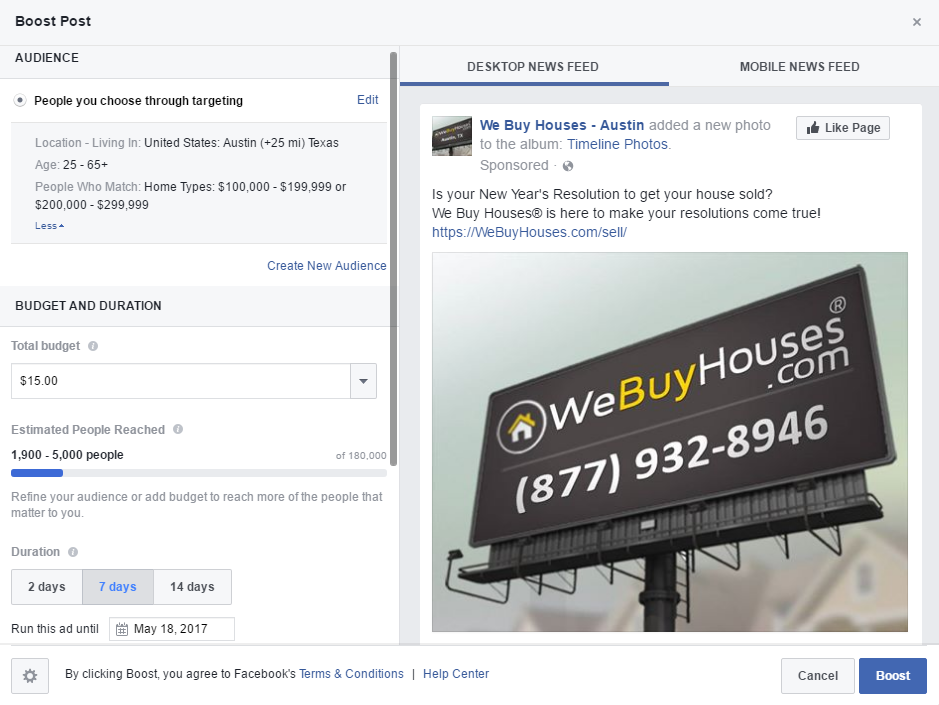
After you place your boost order, it may take some time for it to be approved. When it is approved, you will get a notification alerting you that the post is being boosted.
Example:
Here is an example of a post that was boosted by our team members at the We Buy Houses® Birmingham & Tuscaloosa Facebook page:
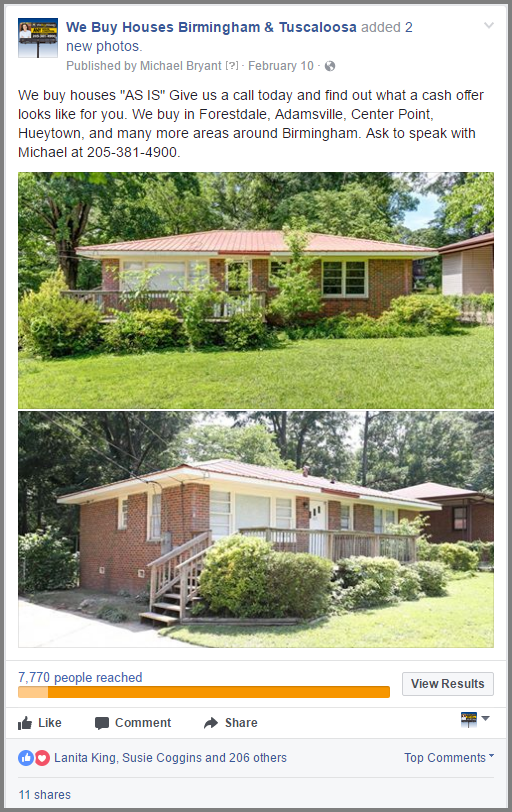
This post has ended up reaching 7,770 people in total since it was posted. The orange bar below the picture shows that most of these people reached were reached because of the boosting campaign. The light orange part is “Organic” views on your post, the dark orange is “Paid” views. After a boosting period on a post is over, you can go in and look at the post’s boost results by clicking the “View Results” button.
Results:
For this post, we can see that it had a total budget of $50, and targeted people 18 and up, who live in 1 location (the Birmingham/Tuscaloosa area).
- Under the Actions tab, is shows that 7,155 people were reached as a result of this boosting
- 538 of the people reached by this posting engaged with the post
- 295 people clicked on the photos
- 8 people liked the We Buy Houses® Birmingham & Tuscaloosa page
- 9 people commented (some asking to rent this or another place from them, some tagged their friends, etc.)
- 11 people shared this post on their own Facebook Wall, showing it to all of their friends and their friends’ friends as a result.
- 538 of the people reached by this posting engaged with the post
That can be some powerful reach for $50.
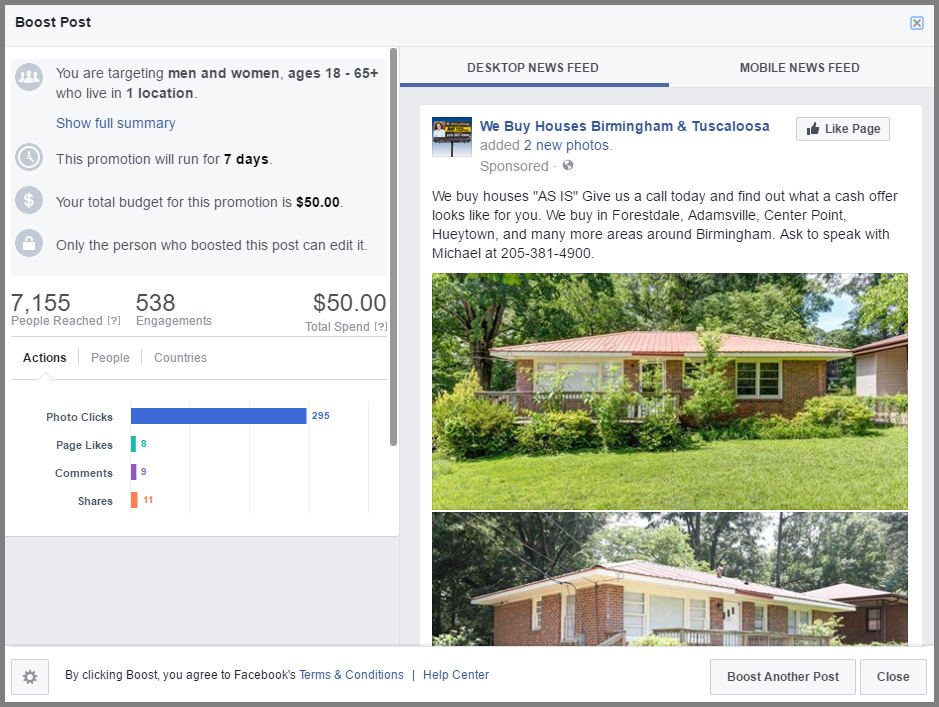
Under the People tab, it shows the age ranges and gender demographics of the people who were reached by your boosted post. This post was viewed by 63.6% women and 36.4% men, and most of them were between the ages of 35 and 44.
- It is important to know that there is more women who use Facebook than men.
- This could mean it might be more effective to have posts that cater more to women than men.
- Often times with things like homes, they will also be targeted slightly more to the female audience, since they are more likely to have included something relevant to our post in their likes, posts, or interests on Facebook.
- This could mean it might be more effective to have posts that cater more to women than men.
- The target market age grouping for real estate is pretty wide, but it may be more cost effective to exclude people under 25, since they are less likely to be in the market for a house.
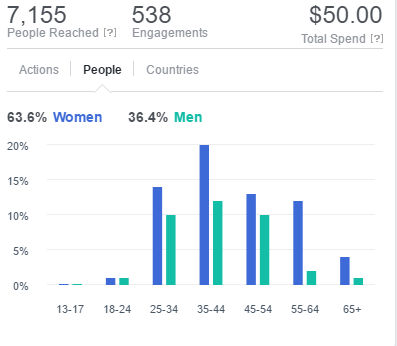
Another way to view your boost’s statistics is to click where it tells you how many people you reached, or the orange bar that compares your organic vs. paid impressions. It will pull up info on how people interacted with your posting.
Here’s an example:
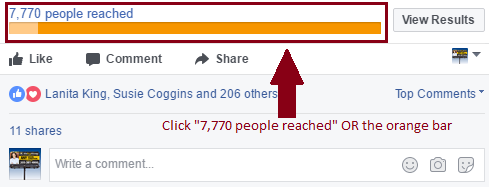
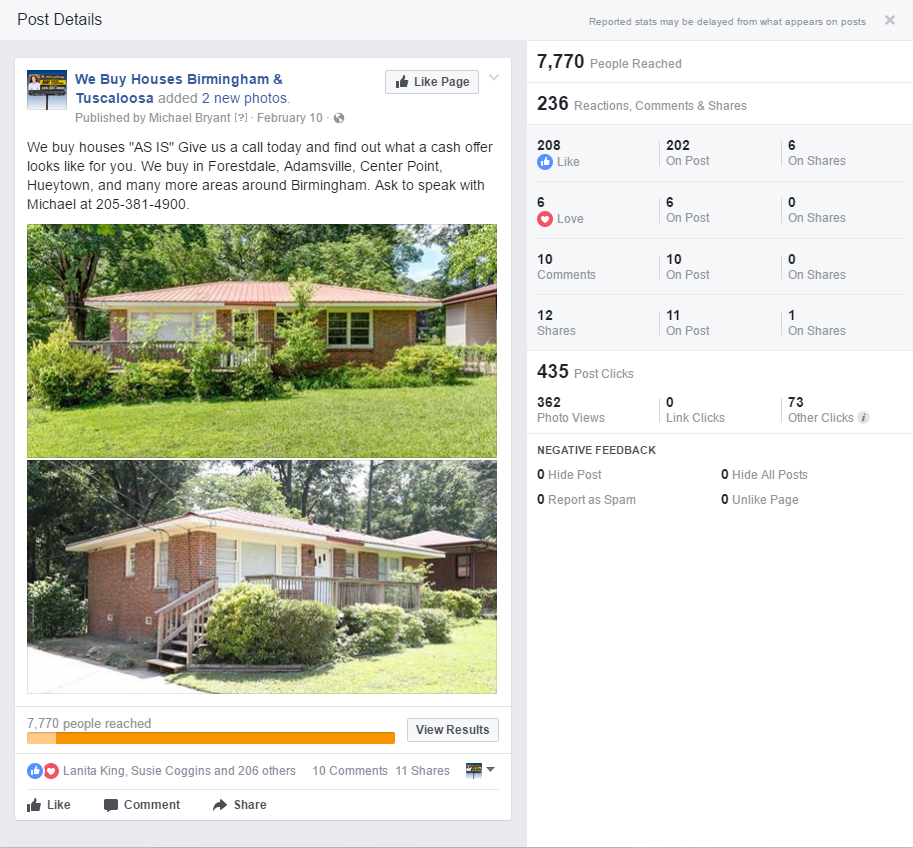
This can show you more specifically where you’re getting your likes and shares from. With this example, you can see a few interesting things:
- 208 people liked this post
- 202 people like the posting by the We Buy Houses® Birmingham & Tuscaloosa Facebook page
- 6 people liked a shared version of the posting, on somebody else’s page
- 6 people loved this posting
- 10 people commented directly to the post
- 12 people shared this posting
- 11 shared the posting from the We Buy Houses® Birmingham & Tuscaloosa Facebook page
- 1 shared a shared posting of this boosted post from somebody else’s page
- 435 people clicked on this post
- 362 people clicked on the pictures in the posting
- 73 clicked elsewhere; either towards the profile page to see other posts, or liked/commented
So far in this posting’s life, it’s reached 7,770 people, and 236 people have interacted with it. Luckily, none of the reactions to this posting resulted in negative feedback.
Taking all of this data into consideration when you subsequently boost another post may make your next post boosting much more effective.
Directions on Creating a Facebook Ad:
Starting the ad:
On the pull-down information tab, there will be a link called “Create Ads” that will direct you to the Facebook Ad Manager.
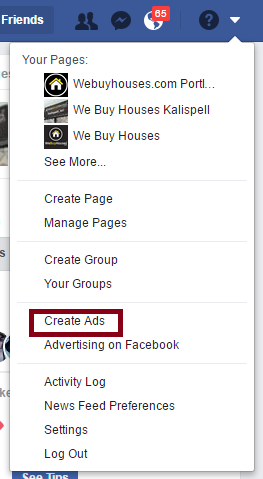
Once in the Ad Manager, you choose your objective for the ad campaign, then choose Set Up Ad Account
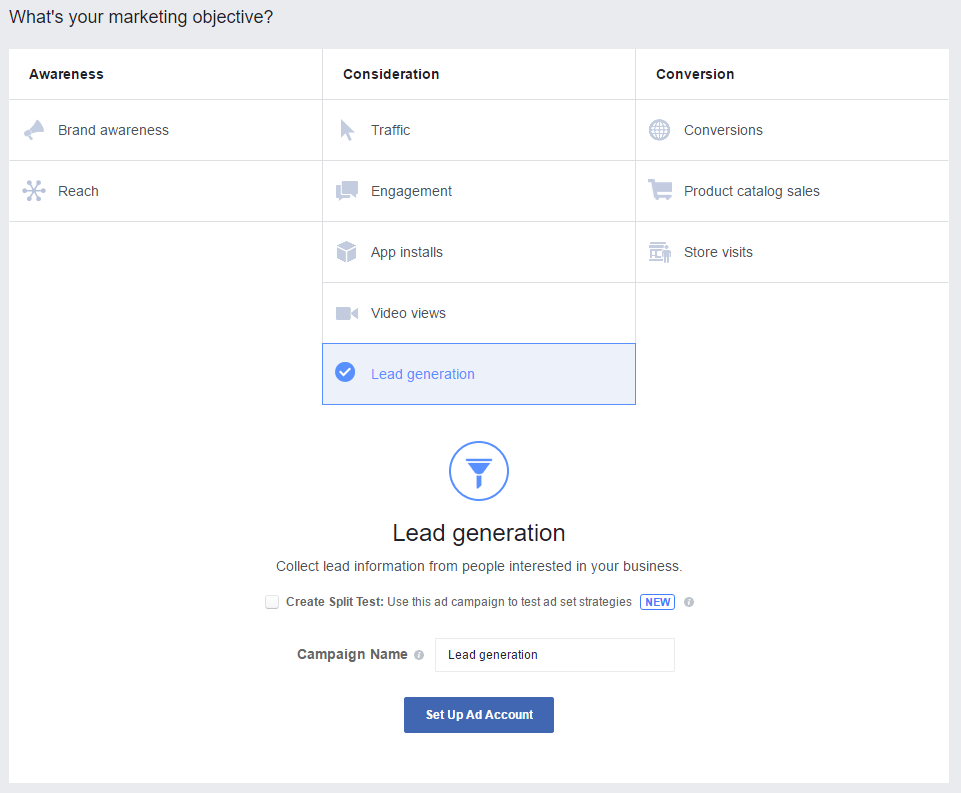
Audience:
From there, you will begin to define your target audience. If you have multiple pages, you can choose a specific page to publish the ad from. In this example, we chose our We Buy Houses® Austin page to host the ad.
- When the targeting specifications get more specific, your Audience Size gets smaller.
- You can even go as far to specify any other demographics that you see as relevant to the quality of your leads in the Detailed Targeting section.
- These can get very specific, and include demographics that most people aren’t aware that Facebook knows about you, such as income/net worth or house value.
- You could even get as specific as having a target audience of 25-45 year olds, who have a house value of 100-200K, who make 100-125K annually, who are single moms that have children in high school, work in the healthcare field, are vegetarian, returned from a vacation within 2 weeks ago, and are a democrat who is likely to be engaged in politics. Will your ad be seen by many people? Not really, but if those are the only people you want to market towards, then you end up not wasting much.
- These can get very specific, and include demographics that most people aren’t aware that Facebook knows about you, such as income/net worth or house value.
In this example, we chose to market to people who live within a 25 mile radius Austin, Texas, who have house values between $100,000 and $300,000, and who are older than 25. These specifications with allow our ad to potentially reach 300,000 people, having an Estimated Daily Reach of 1,500-5,800 people. Once you have a target market you’re satisfied with, you can save these specific demographics in order to target the same market again in the future.
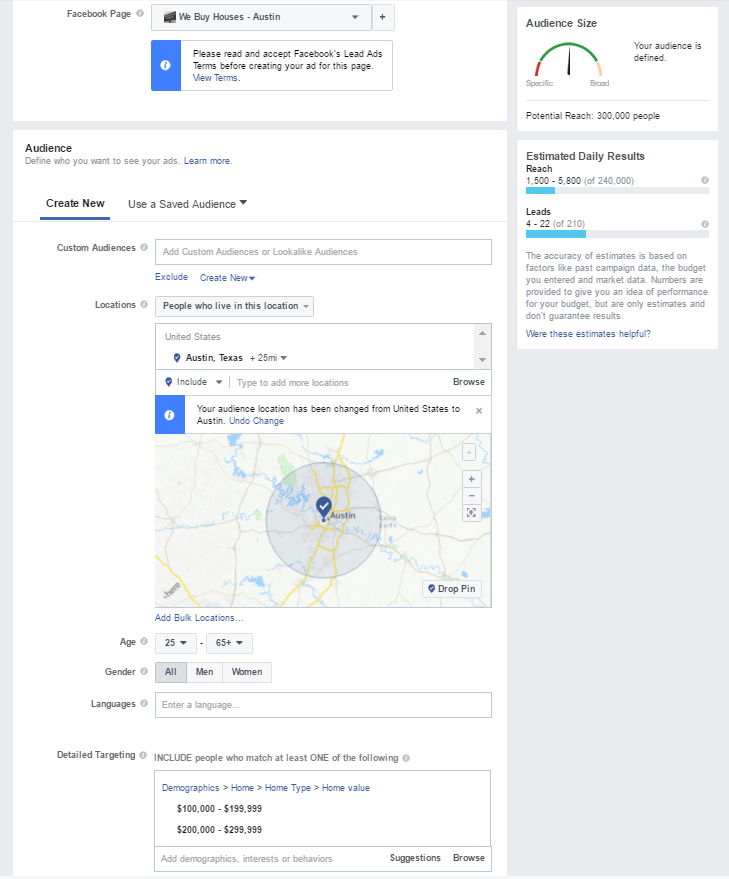
Campaign & Bid Settings:
- Create an Ad Set Name for this set of demographics.
- When setting a budget, anticipate to spend at least $10/day and then build up as you create more ads.
- You can set a start and end date for when the campaign would run, or you can choose to let it run continuously starting today.
- When you are bidding for clicks, manually set your maximum bid.
- Below, you will notice they give you a suggested bid. Bid HIGHER.
- Ex. Suggested bid is $15.31-$32.82, bid $35-$40.
- What this does is it guarantees that your ad will be shown before your competitors. In reality, you are not really getting charged that much every time.
- It is also important to note that you are paying for these ads per impression, not per click.
- Below, you will notice they give you a suggested bid. Bid HIGHER.
- Just like in Google AdWords, you can choose to have either Standard Delivery, which tries to space your ads out and stretch your budget, or Accelerated Delivery, which may spend your budget much more quickly, but will give you more exposure to your targeted audience in a shorter amount of time.
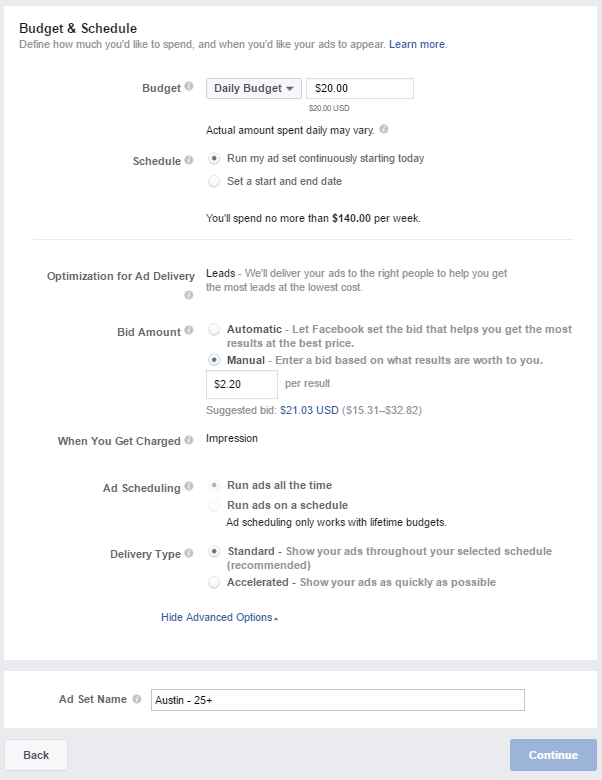
Facebook may not spend your budget for the day, especially if it isn’t set to an Accelerated Delivery Type. Facebook will only serve your ad to your selected audience, so if it is too targeted, you will not be charged your whole budget. If this happens, you have the option of either increasing your target audience or lowering your budget. Keeping your budget as-is would not hurt you either if you choose to do so.
After you place your order, it may take some time for it to be approved. When it is approved, you will get a notification alerting you that the ad is live.
Ad Types:
First, decide which type of Ad Format you want to use:

Once you have chosen your format, then you can begin to create your ad copy. For my example, I chose the single image ad.
- When thinking about what to enter for the Headline and Description, think of something that corresponds and contains the same message as your Facebook Page or Website. You don’t get very much space, so it’s generally a good idea to keep it simple and straightforward.
- The picture you choose will be what catches your audience’s attention. Find something relevant and eye-catching. Remember: Don’t use anybody else’s images/logos in your ad.
- It is also an important thing to consider that Facebook really doesn’t want the picture you use to have more than 25% of it as text. They honestly would prefer if pictures contained no words, because it’s seen as more effective to use the description and the header for text, and just use the picture for a picture. The example for Birmingham down below might not even be permitted to run as a Facebook ad, as it has a fairly large amount of text in the picture.
- We can create custom Facebook ads for licensees upon request – here’s an example:
- It is also an important thing to consider that Facebook really doesn’t want the picture you use to have more than 25% of it as text. They honestly would prefer if pictures contained no words, because it’s seen as more effective to use the description and the header for text, and just use the picture for a picture. The example for Birmingham down below might not even be permitted to run as a Facebook ad, as it has a fairly large amount of text in the picture.
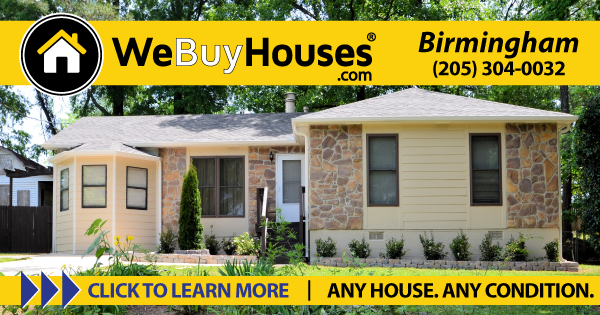
- If you are creating multiple ads, it’s best to keep your descriptions fairly consistent throughout.
- You can preview how your ad will appear on different platforms (Desktop News Feed, Mobile News Feed, or Right Column) to ensure it’s effectiveness wherever it may turn up.
- In this example, I chose my call to action as “Get Quote”
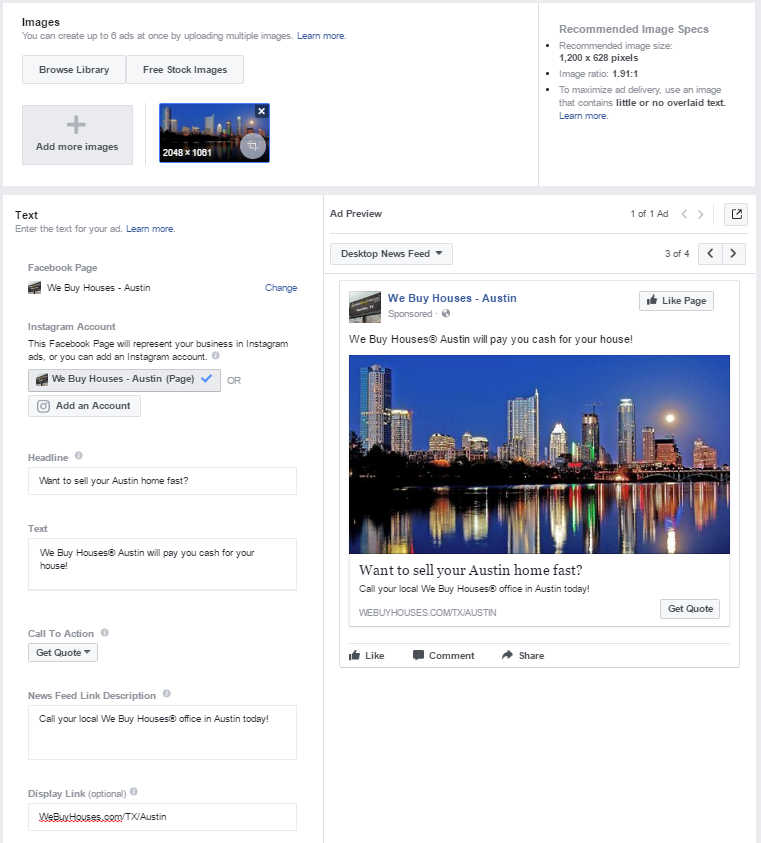
- You can also create a lead form associated with the call to action button. In this example, ours just asks for the lead’s name, phone number, address.
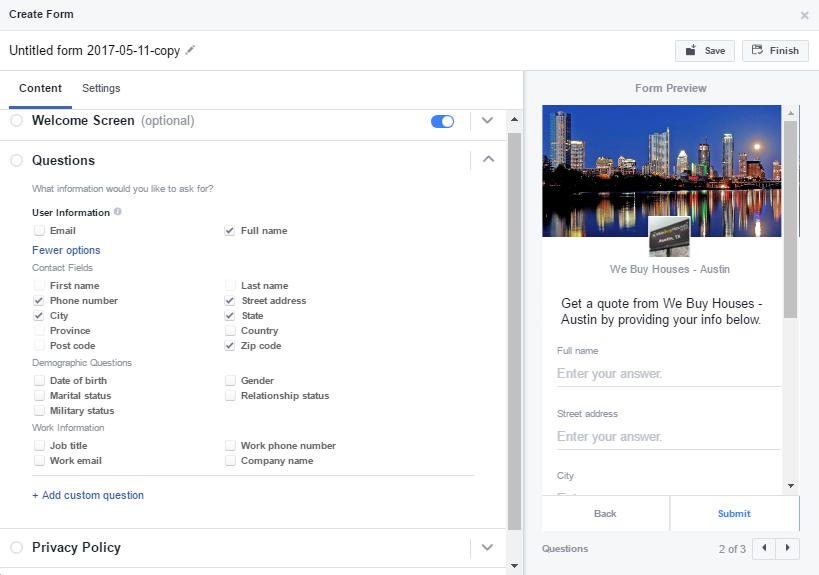
Once you’ve completed this, your ad campaign is ready. As stated before, after you place your order, it may take some time for it to be approved. When it is approved, you will get a notification alerting you that the ad is live.
Facebook Advertising Examples:
Examples of how your ad may look after it is live:
Right Column:
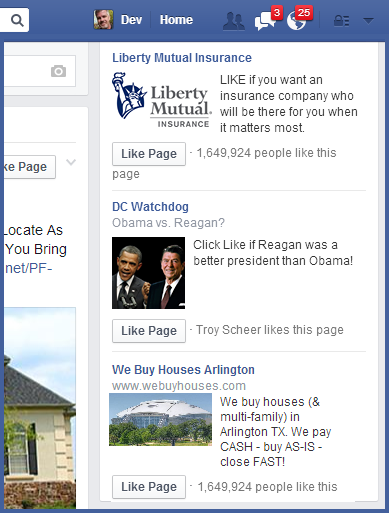
News Feed:

//

